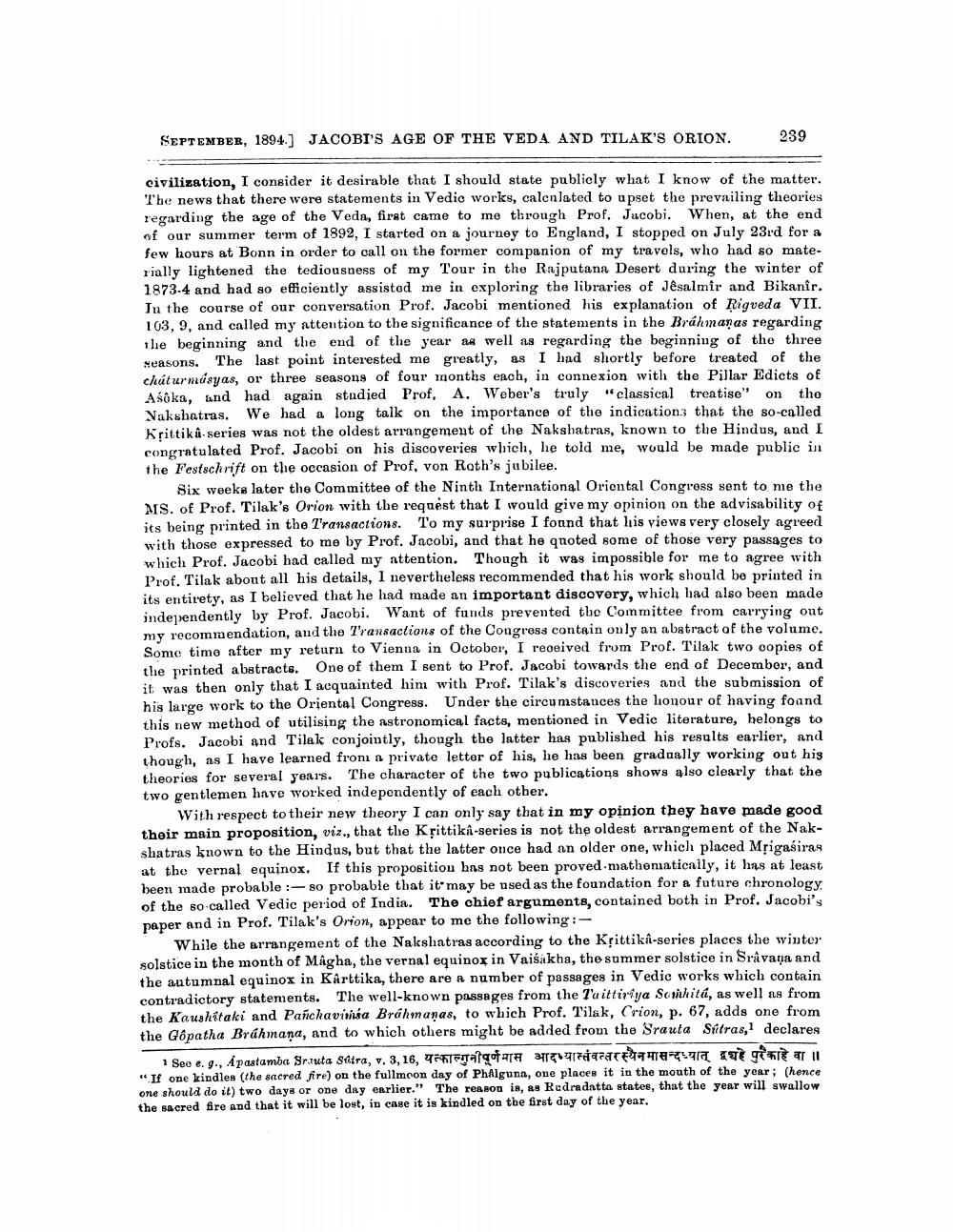________________
SEPTEMBER, 1894.) JACOBI'S AGE OF THE VEDA AND TILAK'S ORION.
239
civilization, I consider it desirable that I should state publicly what I know of the matter. The news that there were statements in Vedic works, calenlated to upset the prevailing theories regarding the age of the Veda, first came to me through Prof. Jacobi. When, at the end of our summer term of 1892, I started on a journey to England, I stopped on July 23rd for a few hours at Bonn in order to call on the former companion of my travels, who had so materially lightened the tediousness of my Tour in the Rajputana Desert during the winter of 1873.4 and had so efficiently assisted me in exploring the libraries of Jêsalmir and Bikanir. In the course of our conversation Prof. Jacobi mentioned his explanation of Rigveda VII. 103, 9, and called my attention to the significance of the statements in the Brahmanas regarding the beginning and the end of the year as well as regarding the beginning of the three seasons. The last point interested me greatly, as I had shortly before treated of the chúturmusyas, or three seasons of four months each, in connexion with the Pillar Edicts of Asoka, and had again studied Prof. A. Weber's truly "classical treatise" on the Nakshatras. We had a long talk on the importance of the indications that the so-called Krittika series was not the oldest arrangement of the Nakshatras, known to the Hindus, and I congratulated Prof. Jacobi on his discoveries which, he told me, would be made public in the Festschrift on the occasion of Prof, von Roth's jubilee.
Six weeks later the Committee of the Ninth International Oriental Congress sent to me the MS. of Prof. Tilak's Orion with the request that I would give my opinion on the advisability of its being printed in the Transactions. To my surprise I found that his views very closely agreed with those expressed to me by Prof. Jacobi, and that he quoted some of those very passages to which Prof. Jacobi had called my attention. Though it was impossible for me to agree with Prof. Tilak about all his details, I nevertheless recommended that his work should be printed in its entirety, as I believed that he had made an important discovery, which had also been made independently by Prof. Jacobi. Want of funds prevented the Committee from carrying out my recommendation, and the Transactions of the Congress contain only an abstract of the volume. Some time after my return to Vienna in October, I received from Prof. Tilak two copies of the printed abstracts. One of them I sent to Prof. Jacobi towards the end of December, and it was then only that I acquainted him with Prof. Tilak's discoveries and the submission of his large work to the Oriental Congress. Under the circumstances the honour of having found this new method of utilising the astronomical facts, mentioned in Vedic literature, belongs to Profs. Jacobi and Tilak conjointly, though the latter has published his results earlier, and though, as I have learned from a private letter of his, he has been gradually working out his theories for several years. The character of the two publications shows also clearly that the two gentlemen have worked independently of each other.
With respect to their new theory I can only say that in my opinion they have made good their main proposition, viz., that the Ksittika-series is not the oldest arrangement of the Nakshatras known to the Hindus, but that the latter once had an older one, which placed Mrigasiras at the vernal equinox. If this proposition has not been proved mathematically, it has at least been made probable :- so probable that it may be used as the foundation for a future chronology of the so-called Vedic period of India. The chief arguments, contained both in Prof. Jacobi's paper and in Prof. Tilak's Orion, appear to me the following:
While the arrangement of the Nakshatras according to the Kittikâ-series places the winter solstice in the month of Magha, the vernal equinox in Vaisakha, the summer solstice in Sråvara and the autumnal equinox in Kårttika, there are a number of passages in Vedic works which contain contradictory statements. The well-known passages from the Taittiriya Surihita, as well as from the Kaushitaki and Panchavitna Brahmanas, to which Prof. Tilak, Crion, p. 67, adds one from the Gópatha Brahmana, and to which others might be added from the Srauta Stitras, declares 1 Sec e. g., A pastamba Sruta satra, v. 3,16, regalgoa
TE V I R ar 11 "If one kindles (the sacred fire) on the fullmoon day of PhAlguna, one places it in the mouth of the year; (hence one should do it) two days or one day earlier." The reason is, as Redradatta states, that the year will swallow the sacred fire and that it will be lost, in case it is kindled on the first day of the year,




